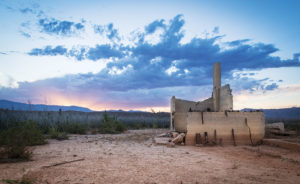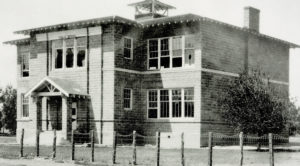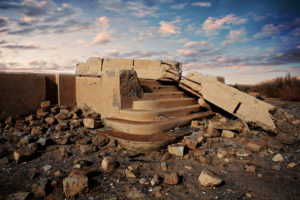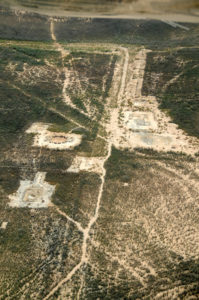St. Thomas
September – October 2019
Ghost town tells a tale of resurrection and fortitude.
BY MICHELLE SINAGRA

St. Thomas seems an unlikely name for a Nevada ghost town. It conjures up Caribbean fantasies of powdered sugar beaches, crystalline waters teaming with marine life, and warm balmy breezes. But this St. Thomas lies in the harshness of the Mojave Desert and its existence is as unlikely as its name. St. Thomas is the story of disappearing and reappearing acts and of final emergence.
The notoriety of St. Thomas is all due to Lake Mead. But the history of the town dates back even further than the lake’s creation and it’s that repeated resurgence of this place that is so intriguing.

RESURRECTION
St. Thomas, like most everything in this part of southern Nevada, lies in an area that was first inhabited by the Anasazi people. They chose the location because of the fertile soil that sits at the convergence of the Muddy and Virgin Rivers. Mormons were the first pioneers to actually settle in St. Thomas and put the town on the map. They arrived in 1865 and established a farming community. These hardworking folks thought that they had settled in Utah; imagine their surprise (and anger) when Nevada officials came to collect three years of unpaid property taxes. Refusing to pay, in 1871 they packed up their belongings, burned their homes to the ground, and left for the Great Salt Lake.

By 1880, new settlers gave life to St. Thomas once again, and the population hovered steadily around several hundred for many years. St. Thomas again emerged as a bustling salt-mining and farming community. At one point there were up to 500 residents who built homes, a church, school, grocery store, ice cream parlor, and even a hotel. Huge cottonwood trees lined the streets and served as shade during the brutally hot summers. With no electricity or running water, these residents lived a simple life.
But in the1930s, plans moved forward for the construction of the Boulder (now Hoover) Dam. Their tranquil lives were disrupted when they were notified that their community would be inundated by the waters of Lake Mead. Evacuations began slowly, and in 1934, the government prepared to move the town’s cemetery. By 1937, the water was 12 miles from the town, and crops were still being grown as tenacious settlers refused to abandon their homes.
In June 1938, as the waters encroached, the last settler climbed from his door to his boat, set his house on fire, and paddled away from his home. St. Thomas hid beneath 60 feet of water for decades until the recent drought. As water levels in Lake Mead receded, St. Thomas re-emerged in 2002.

IT’S HERE, FOR NOW
One of the best parts about getting to St. Thomas is, well, getting there. Northshore Road is a two-lane ribbon of a road that weaves through the Lake Mead National Recreation Area. Just minutes north of Las Vegas, it feels like another world. Yes, in summer, it may be the closest thing to an inferno: dry and seemingly lifeless. But in the reprieve of cooler months, when you can roll your car windows down to feel the warmth of the sun and the caress of the breeze, every twist and turn of this drive is a delight.
The layers of rolling hills—black, grey, tan, and orange—create a patchwork that spreads on for miles as you pass near Bowl of Fire, Redstone Dunes, and Valley of Fire. There are occasional glimpses of Lake Mead, its deep azure creating a sharp contrast between the mountains and the deep blue of the sky.

Today, the National Park Service has embraced this little gem and given the town and its past residents the honor due them. They maintain the 3-mile dirt road that ends on a small bluff. From there, exploring the town is all on foot by way of a 2.5 mile-walking loop. Interpretive signs are posted all along the way and tell the story of these hearty people, this unique place, and its history.
Walking along the dirt path to the town, there are seashells scattered everywhere, a reminder that this town was once like the fabled Atlantis. Most of the buildings are just foundations, but looking at the water cisterns, the bulging tree stumps, and steps leading up to rubble, it is easy to imagine children playing in front of the school, mothers purchasing goods at the grocery store, and families strolling to the ice cream parlor to refresh themselves in the warm evenings under the shade of the cottonwoods.
It confounds the mind to think about how these people lived without so many conveniences and yet how hard it must have been to turn their backs on their homes, their community, and unique lifestyle. Sometimes, thanks to ghost towns, history puts things into perspective.
VISIT WHILE YOU CAN
St. Thomas
Lake Mead National Recreation Area
nps.gov, 702-293-8990

